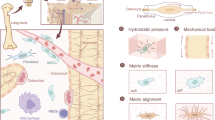Summary
The capacity of bone to organize and reorganize its structure in response to changing mechanical demands is well recognized. However, the mechanism by which the changing mechanical environment is detected, and the means by which this information is translated into a stimulus for structural modification, are not understood. A group of substances suggested to be involved in the initial transduction of strain information are the prostaglandins. In this experiment we used a single period of dynamic loading to stimulate an adaptive osteogenic responsein vivo. Loading was performed in the presence and absence of indomethacin. Measurements of the periosteum 5 days after loading showed that the presence of indomethacin at the time of loading reduced the osteogenic response. Though consistent with the hypothesis that prostaglandins are involved in the initial transduction of tissue strain into a biochemical response, this result is not sufficient to demonstrate this conclusively because reduced prostaglandin levels during the 24 hours immediately after the period of loading may affect many other points in the cascade of events between strain transduction and adaptive new bone formation. Furthermore, indomethacin at the relatively high levels we used (40 mg/kg) may have effects other than those on prostaglandin synthesis.
Similar content being viewed by others
References
Rubin CT, Lanyon LE (1985) Regulation of bone mass by mechanical strain magnitude. Calcif Tissue Int 37:411–417
Pead MJ, Lanyon LE (1988) Direct transformation from quiescence to bone formation in the adult periosteum following a single brief period of physical load bearing. J Bone Min Res 3:647–656
El Haj A, Pead MJ, Skerry TM, Suswillo R, Minter SL, Rawlinson SCF, Ali NN, Lanyon LE (1988) Early cellular responses in load-related adaptive bone remodelling. Proc Bone and Tooth Soc, Sept 1987 Bone 9:255
Yeh C-K, Rodan GR (1984) Tensile forces enhance prostaglandin E synthesis in osteoblastic cells grown on collagen ribbons. Calcif Tissue Int 36:S67-S71
Binderman I, Shimshoni Z, Somjen D (1984) Biochemical pathways involved in the translation of physical stimulus into biological message. Calcif Tissue Int 36:S82-S85
Feyen JHM, Di Bon A, van der Plas A, Lowik CWGM, Nijweide PJ (1985) Effects of exogenous prostanoids on the proliferation of osteoblast-like cells in vitro. Prostaglandins 30:827–841
Chambers TJ (1985) The pathobiology of the osteoclast. J Clin Pathol 38:241–252
Rubin CT, Lanyon LE (1984) Regulation of bone formation by applied dynamic loads. J Bone Joint Surg 66A:397–402
Ralis ZA, Ralis HM (1975) A simple method for demonstration of osteoid in paraffin sections. Laboratory Technology 32:203–213
Roberts WE, Mozsary PG, Klingler E (1982) Nuclear size as a marker for osteoblast differentiation. Am J Anat 165:373–384
Rozengurt E (1986) Early signals in the mitogenic response. Science 234:161–166
Skerry T, Lanyon LE (1988) Change in proteoglycan orientation during loading: a possible mechanism for a strain memory in bone? J Orthop Res 6:547–551
Shen V, Rifas L, Kohler G, Peck WA (1986) Prostaglandins change cell shape and increase intercellular gap junctions in osteoblasts cultured from rat fetal calvaria. J Bone Min Res 1:243–249
Chyun YS, Raisz LG (1984) Stimulation of bone formation by prostaglandin E2. Prostagandins 27:97–103
Gera I, Hock JM, Gunness-Hey M, Fonseca J, Raisz LG (1987) Indomethacin does not inhibit the anabolic effect of parathyroid hormone on the long bones of rats. Calcif Tissue Int 40:206–211
Kantor HS, Hampton M (1978) Indomethacin in submicromolar concentrations inhibits cyclic AMP-dependent protein kinase. Nature 276:841–842
Curtis TA, Ashrafi SH, Weber DF (1985) Canalicular communication in the cortices of human long bones. Anat Rec 212:336–344
Jee WS, Ueno K, Kimmel DB, Woodbury DM, Price P, Woodbury LA (1987) The role of bone cells in increasing metaphyseal hard tissue in rapidly growing rats treated with prostaglandin E2. Bone 8:171–178
Author information
Authors and Affiliations
Rights and permissions
About this article
Cite this article
Pead, M.J., Lanyon, L.E. Indomethacin modulation of load-related stimulation of new bone formationin vivo . Calcif Tissue Int 45, 34–40 (1989). https://doi.org/10.1007/BF02556658
Received:
Revised:
Issue Date:
DOI: https://doi.org/10.1007/BF02556658




